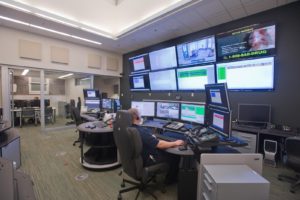 This is the first in a series of articles examining some of the major events and issues that the Department of Public Safety experienced in the 2011-12 academic year. First, we’ll examine the new Emergency Communications Center, which opened for use on July 1, 2011, the first of a three-phase update to DPS offices in the basement of Sims Hall.
This is the first in a series of articles examining some of the major events and issues that the Department of Public Safety experienced in the 2011-12 academic year. First, we’ll examine the new Emergency Communications Center, which opened for use on July 1, 2011, the first of a three-phase update to DPS offices in the basement of Sims Hall.
Our dispatch staff consists of a manager, four supervisors, and five full-time dispatchers (one who works only during the academic year); along with several public safety officers and community service officers who are trained to step in should the need for overtime arise. In addition to answering every call, blue light alarm, elevator alarm, and emergency text message that the department receives, DPS dispatchers monitor campus alarm systems and act as problem-solvers for callers who turn to DPS when they don’t know who else to contact (or after normal business hours or on weekends, when DPS is one of the few campus offices open).
Taking a look at the year that was in the communications center, Communications Center Manager Jim Santoferrara put together an analysis of just how much busier this year has been compared to recent years past.
May ’08 – May ’09: 51,501
May ’09 – May ’10: 51,164
May ’10 – May ’11: 48,776
May ’11 – May ’12: 67,969
The call total from 2011-12 is a 39% increase over the previous year. That’s a remarkable increase, and seems even more so from a logistics standpoint, because there are usually only two or three dispatchers on duty at one time. They handle an array of calls, from the mundane – a student locked out of his apartment, or an alarmed door held open – to the incredibly serious, including crimes in progress.
This year, the communications center had two dispatchers depart and trained a new dispatcher. Training lasts 12 weeks, packed full of lessons on campus geography, learning and accessing the multitude of resources available to public safety dispatchers, and most importantly, learning how to keep DPS officers safe.
“Part of our job is thinking about [the officers’] safety along with them,” Santoferrara said. He noted that dispatchers often have to think two steps ahead when a call comes in – they must know how many units to send, when to send them, and what information to get to the responding officers.
Even with the changes and additions, the 39% increase in calls, and the stress inherent in their jobs, the DPS dispatchers did a phenomenal job this year, adapting to everything that came their way.
